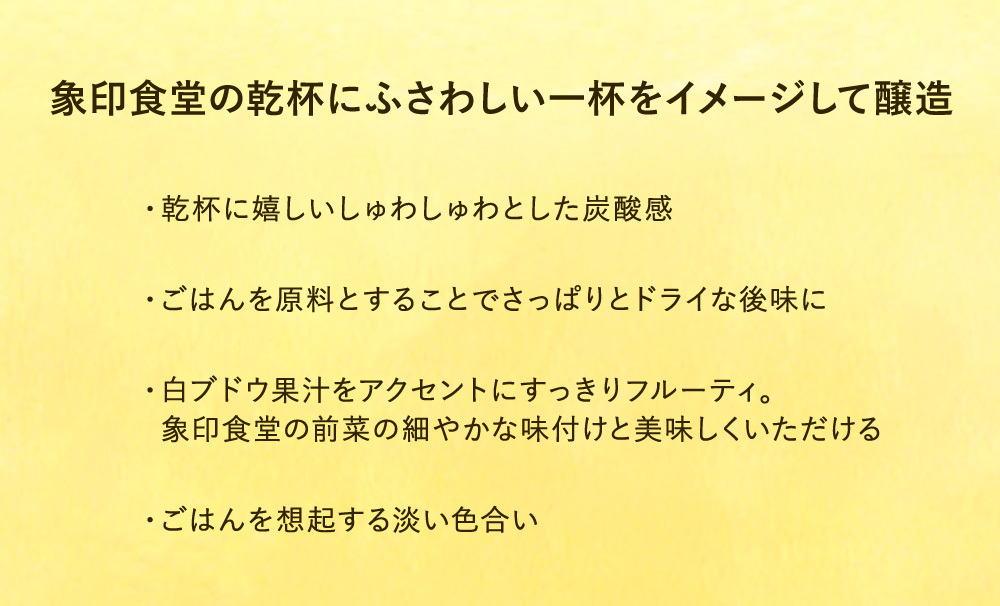Note: This website was automatically translated, so some terms or nuances may not be completely accurate.
Zojirushi and Rice Craft Beer! What is Upcycling Achieved Through Cross-Industry Collaboration?

Miwa Kurisu
Zojirushi Mahobin Co., Ltd.

Takuma Yamamiya
ISEKADO (Ise Kadoya Brewery)

Yano Takashi
Dentsu Inc.

Keisuke Kamiichi
Dentsu Inc.
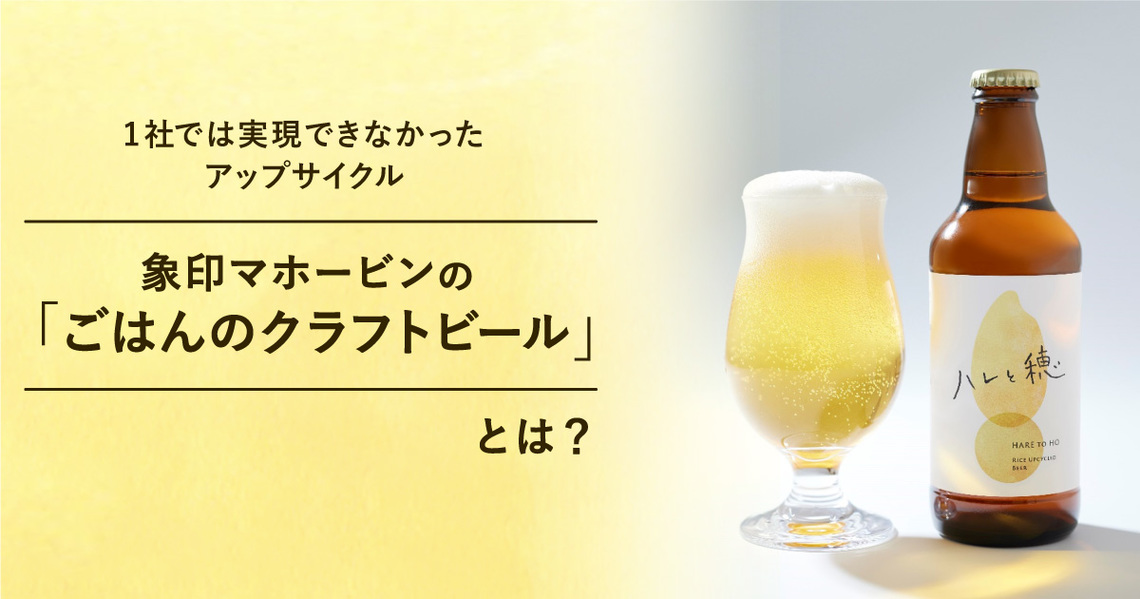
In manufacturing, various losses occur within the supply chain. From an SDGs perspective, the concept of "upcycling" (creative reuse) involves utilizing materials that would otherwise be waste and transforming them into new products with added value, rather than simply recycling.
Zojirushi Mahobin has been working on upcycling "test rice" used in rice cooker development. The focus here is "Hare to Ho," a craft beer upcycled from this test rice.
To create "Hare to Ho," Zojirushi collaborated with craft beer brewery ISEKADO (Ise Kado Brewery), food loss reduction startup CRUST Group, and Dentsu Inc.
How did these companies, each dedicated to flavor, achieve a delicious upcycling solution impossible for any single company alone? We heard their story in a roundtable discussion format featuring Zojirushi × ISEKADO × Dentsu Inc.
<Table of Contents>
▼Zojirushi's challenge was the massive amount of "rice" used during rice cooker development
▼A concept statement that brought together the expertise of professionals from diverse fields
▼Feeling the potential of upcycling through cross-industry collaboration
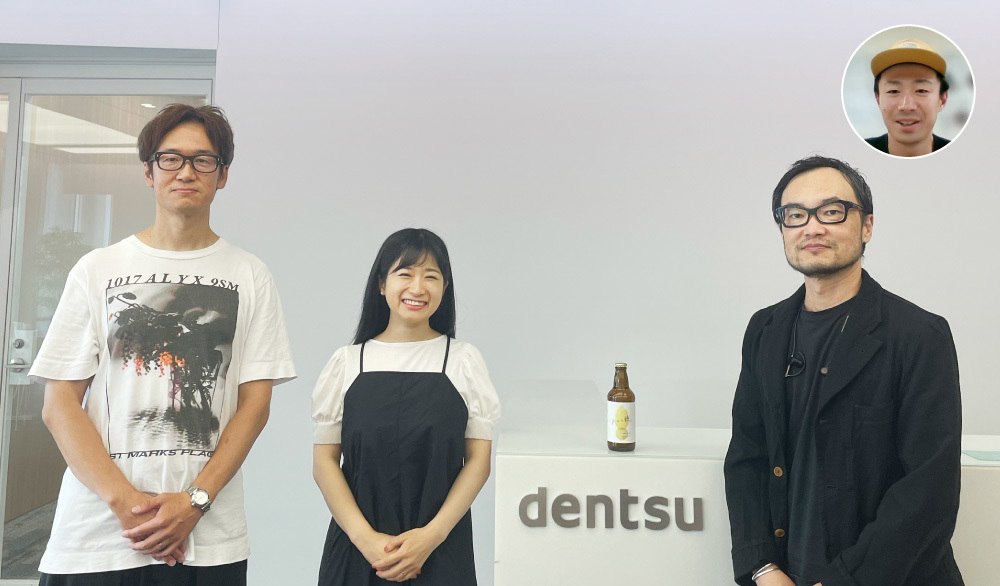
Zojirushi's challenge was the large amount of "rice" used during rice cooker development
──First, please tell us about your roles in the "Hare to Ho" project.
Kurisu: I'm Miwa Kurisu from Zojirushi Mahobin's (hereafter Zojirushi) New Business Development Office. This time, I coordinated the overall project with everyone's support.
Yamamiya: I'm Yamamiya, Quality Control Manager and Brewer at ISEKADO. I handle the product development of the beer itself—essentially designing the "contents."
Yano: I worked alongside Kamiichi as part of the Dentsu Inc. team, primarily assisting with the creative aspects. My usual role is as a broad creative director, handling mass advertising as well as solutions for various social issues.
Kamisho: I was consulted by Zojirushi and handled the overall production for this project, starting from the initial proposal.

── "Hare to Ho" generated significant buzz, frequently featured in media coverage.
Kamisho: It sold out incredibly fast, and ISEKADO's inventory is already depleted, right? (※)
※At the time of interview. As of October 2023, it is being resold on the ISEKADO online shop and other platforms.
Kurisu: Thanks to everyone, I believe the initial production run of 5,000 bottles has already sold out completely. It was sold through various channels: ISEKADO's contracted distributors, retailers, and the ISEKADO online shop. A friend of mine even said they bought it directly at the ISEKADO factory.
Yamamiya: In today's craft beer scene, "rice-based beer" is becoming quite the trend. It allows us to create very interesting beers, which we're grateful for. Our beers don't often get featured on TV, so internally, we were thrilled to see "Our beer's on TV!" (laughs).
──Could you tell us about the challenges Zojirushi faced when taking on this project?
Kurisu: Zojirushi is a company where nearly half of our sales come from rice cookers. Our developers work hard every day, cooking rice while experimenting to figure out what kind of rice cooker to deliver to our customers.
Researching and developing new rice cookers requires cooking large amounts of rice, which we call "test rice." The development team mentioned they simply couldn't eat it all. The leftover rice was being composted at considerable expense.
──How did the upcycling initiative begin?
Kurisu: Our first initiative was collaborating with a company called FermenStation to upcycle the rice into ethanol, which we then used to make wet wipes. However, we could only produce "marketable quantities" of wet wipes, so we were exploring other ways to utilize the test rice. That's when we had the opportunity to consult with Mr. Kamiichi.
Kamiichi: When we first discussed it, we were literally drinking beer together, right? (laughs) Right then and there, I mentioned, "There's a company that can upcycle rice into beer."
For this project, we asked CRUST Group—which has proven track records both domestically and internationally—to help us create upcycled beer using the "cooked test rice" provided by Zojirushi. As a result, they connected us with ISEKADO, making the upcycled beer possible. Dentsu Inc. primarily handled the overall production, concept, copy, and design.
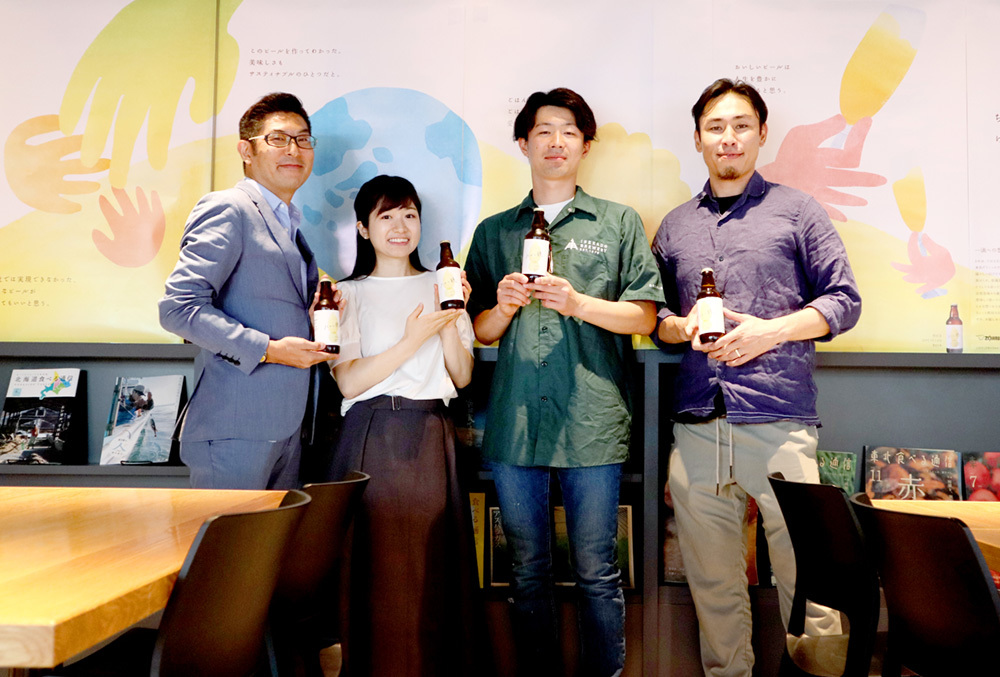
Launch: CRUST Group is a Singapore-based startup with expertise in upcycling various materials into beverages like beer. They match companies supplying raw materials, like Zojirushi, with beverage makers or breweries like ISEKADO, providing recipes and support.
I've been actively engaging with various overseas startups, inviting them to Japan—particularly the Kansai region—to collaborate with Japanese companies. CRUST Group also has a Japanese subsidiary in Osaka. So, when I heard about Zojirushi's challenge, they immediately came to mind.
Kurisu: I strongly resonated with CRUST Group's vision to "reduce global food loss by 1%." From there, the three companies—CRUST Group, Dentsu Inc., and myself—held a meeting, and I was introduced to ISEKADO. The CRUST Group representative passionately stated, "ISEKADO shares a very similar philosophy on manufacturing with Zojirushi, and I can vouch for them wholeheartedly."
Kamisho: They passionately argued, "Precisely because Zojirushi is Japan's premier rice cooker maker, they absolutely need ISEKADO, who brews world-class beer." Among various criteria, their commitment to flavor, expertise in craft beer development using diverse ingredients, and the fact they chose us from the Kansai region were major factors.
Kurisu: Shipping cooked rice frozen to distant locations causes energy loss. Within the Kinki region, that loss is minimal. When I met with ISEKADO's president, I really felt their pride in their beer. We conveyed our desire to create pairings with the rice and side dishes at "Zojirushi Shokudo" and our wish to use plenty of their rice.
Rice Restaurant "Zojirushi Shokudo"
https://www.zojirushisyokudo.com/shokudo/
Kamiichi: ISEKADO holds the strong conviction that "we only create things that can compete globally." I think Zouin's desire to "create delicious things" resonated with them.
A concept statement that brings together the expertise of professionals from various fields
──Mr. Yamamiya, what were your initial thoughts when you first heard about this project?
Yamamiya: Our sales rep approached me with the idea: "Can we make beer using rice... no, wait, 'cooked rice'?" Hearing this, I realized that upcycling rice that would otherwise be wasted was indeed important from an SDGs perspective. That said, our brewing plant wasn't designed for rice, so it was challenging. Still, I planned the lab work while imagining, "If we were actually to brew using rice, how would we implement it?"
Kamiichi: Just now, Mr. Yamamiya, you changed "rice" to "cooked rice." You mentioned that it was precisely because it was "cooked rice" that it matched ISEKADO's manufacturing process, right?
Yamamiya: Yes. Cooking rice involves converting the starch into an alpha state, making it soluble and digestible for humans. In beer brewing, yeast also breaks down starch into a form it can consume. In that sense, having "already cooked rice" was incredibly easy to handle. Simply mixing malt, water, and rice allowed the malt-derived enzymes to break down the starch into a form suitable for fermentation.

――Is it common for craft beer to use ingredients other than malt?
Yamamiya: Craft beers often use adjuncts. Well-known examples include beers using yuzu peel, coriander, spices, sake lees, or cocoa.
Kamiichi: Actually, since we released "Hare to Ho," I get tons of inquiries like, "Can you make beer with this?" I'm thinking of just sending them all to Yamamiya-san (laughs).
── Was there a phase with "Hare to Hō" where Mr. Yamamiya made many prototypes?
Yamamiya: No, our company doesn't have a pilot plant. Our brewing plant is sized to produce at least 2000 liters, which translates to 5000-5500 bottles of beer. So, we tasted and discussed a rice beer we'd previously made as a limited edition product, incorporated Zojirushi's requests, designed the product, and finalized the recipe.
Yano: Given your extensive knowledge, experience, and data, I imagine you had a very clear vision of the final product. Yet it feels like a "one-shot deal," doesn't it?

Kurisu: This time, I wondered if there might be differences in the manufacturing mindset between industries. At Zojirushi, they do extensive product prototyping to confirm they can "absolutely reproduce the targeted state" before moving to mass production. On the other hand, craft beer companies sometimes enjoy the slight variation in each bottle, creating synergistic effects from the combination of ingredients at that moment – something mass-production companies can't replicate.
Yamamiya: That's right. In the craft beer industry, there's this idea that "it doesn't have to be completely uniform." It started as a kind of counterpoint to the big beer companies that emphasize "every single one being the same quality."
Kurisu: Studying craft beer this time really made me understand that's where the appeal lies.
――So, different industries really do have different approaches to manufacturing.
Kurisu: At Zojirushi, if there's no consensus on "What to make and how to make it?", the project won't get approved. Even when developing everyday rice cookers or stainless steel bottles, we constantly ask ourselves, "What kind of experience will our customers have through the products we create?"
Kamiichi: This time, I believe Yamamiya-san received requests from Zojirushi outlining their vision for the recipe – "We want it to be like this." And what's amazing is the groundwork Zojirushi did beforehand. They tasted every conceivable beer, researching "this kind of flavor" and "this kind of color," right?
Kurisu: It's such a deep world that "every conceivable kind" might be an overstatement (laughs). The ISEKADO sales rep told us, "ISEKADO is the pitcher, and Zojirushi is the catcher. If you set up ready to catch it here, we'll throw it there." So we studied that "setup." We explored how to verbalize it so our mutual understanding aligned.
Yamamiya: The tricky part is that there's this "craft beer sensibility." It has a different linguistic feel compared to food or general sensibilities, so we made sure to double-check that we weren't misinterpreting it. This time, Zojirushi requested aspects we hadn't consciously focused on in our usual beer-making, like evoking the fizzy sensation of champagne or the texture.
Kurisu: Regarding verbalizing craft beer, Mr. Yano was also a tremendous help.
Yano: Within Zojirushi, there was this big concept of "the beer served at Zojirushi Shokudo," right? But I don't think people ordering beer are consciously thinking about upcycling. We really needed to clearly define its identity as a beer first. We proposed designing it in this order: first, think deeply about "what kind of people should drink this, and in what kind of mood?" Then, only after that, reveal, "Actually, this beer was born from the concept of upcycling."
Kichijo: The biggest concern on Dentsu Inc.'s side was that opening up supply chain challenges was very challenging for Zojirushi. So above all, we focused on "how to get users to empathize." Simply saying "it's a delicious beer" wasn't right, but saying "drink it because it's upcycled" wasn't right either. We had quite a few discussions about getting that balance just right.
Kurisu: Upcycled products need added value to be viable as a business. So, when considering our existing assets, we realized we had "Zojirushi Shokudo," a restaurant particularly popular with female customers. We decided to focus intensely on "the scene within Zojirushi Shokudo."
Also, once we decided to make beer using upcycled rice, we first had Yano-san write the concept statement. That became the foundation for product design, packaging, and even the name. Everyone genuinely thought, "That's cool!" about Yano-san's concept, and that's what really got things moving.
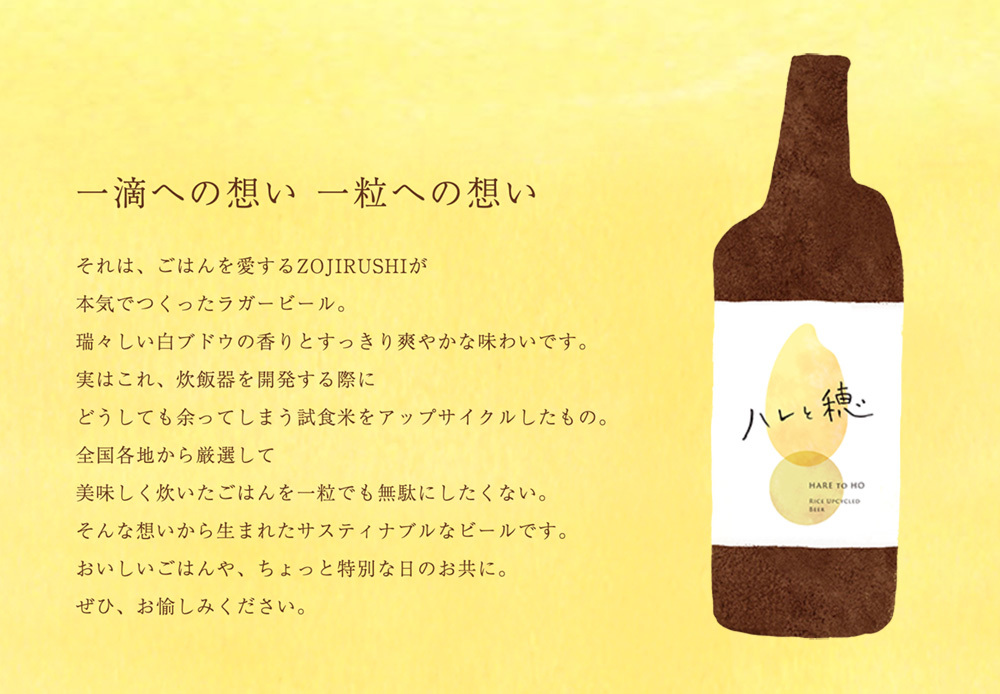
──Mr. Yano also handled the product name and design, right?
Yano: Since Zojirushi strongly wanted "a beer women would drink on special occasions," I proposed the name "Hare to Ho" (Celebration and Grain). For the design, I included the lead copy "Thoughts for a Drop, Thoughts for a Grain." I symbolically incorporated the "drop" of beer and the "grain" of rice into the design.
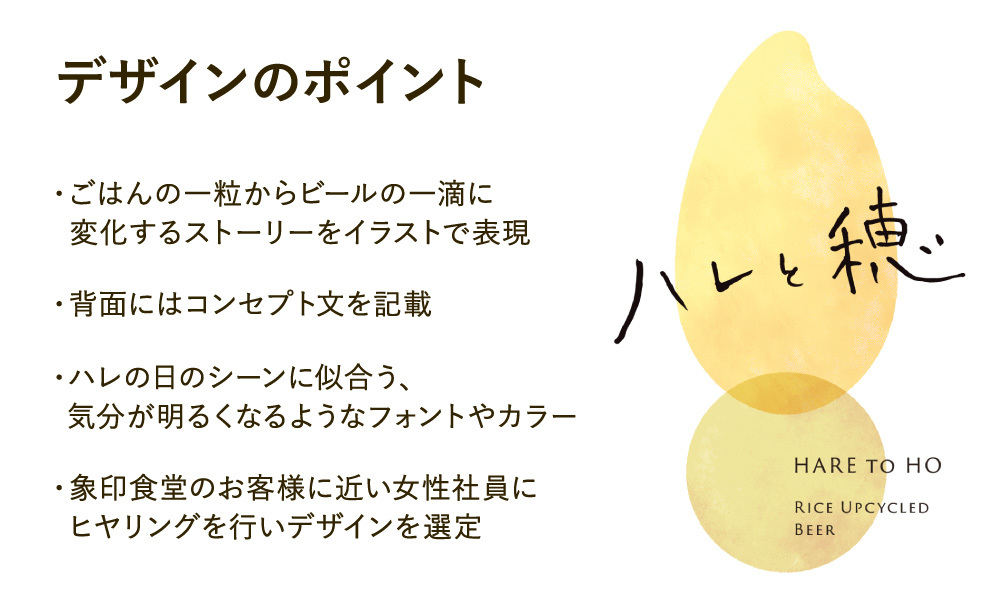 Kurisu: I find great significance in how professionals from various fields participated in this upcycling initiative, pooling their wisdom and skills. By sharing the image of "a scene inside Zojirushi Shokudo" and Yano-san's concept text, we never lost sight of what to focus the outstanding technologies of ISEKADO, Dentsu Inc., and Zojirushi on.
Kurisu: I find great significance in how professionals from various fields participated in this upcycling initiative, pooling their wisdom and skills. By sharing the image of "a scene inside Zojirushi Shokudo" and Yano-san's concept text, we never lost sight of what to focus the outstanding technologies of ISEKADO, Dentsu Inc., and Zojirushi on.
Kichijo: The concept statement truly served as our rallying cry for bringing diverse experts together on this project. First, we wanted people to experience "deliciousness," and then, through that, communicate the concept of upcycling to the world.
Yano: Initially, Zojirushi, with their deep passion for rice, suggested bringing "One Grain of Care" to the forefront. But for beer drinkers, wouldn't "One Drop" come first? At that point, Mr. Kurisu skillfully consolidated Zojirushi's perspective, which made progress much smoother.
With a new challenge like this, especially a collaboration bringing so many people together, progress can stall easily. But at various critical junctures, Mr. Kurisu decisively said, "Leave that to me," and that's how we kept moving forward.
Kurisu: At that point, I just trusted Yano and pushed through (laughs).
Kamiichi: ISEKADO also absolutely insisted on "deliciousness" being non-negotiable. In that sense, bringing the beer's "first drop" to the forefront helped unify everyone's focus throughout the entire process.
──What kind of verbalized vision did Zojirushi have for ISEKADO in terms of "this is the kind of beer we want"?
Kamiichi: "Women sharing a champagne-like toast before a meal," "being able to appreciate the subtle flavor differences in appetizers," "enjoyable for both those who aren't big drinkers and those who love beer," "like savoring Zojirushi Shokudo's famous rice after the beer." They had done extensive research and provided very detailed requests.
Yamamiya: Previously, when collaborating with other companies to make beer, we'd often just get a rough idea and be told, "The rest is up to you, ISEKADO!" This was our first experience working together like this.
We received specific ideas—flavor profiles, color tones, desired food pairings—and then developed the recipe by figuring out how to achieve those goals. We're glad it worked out well and they were pleased with the result. It made me appreciate the value of aligning our craft beer language with more common language in the creation process.
I sensed the potential for upcycling through cross-industry collaboration
──This project became a great example of how waste generated during our own product development can be upcycled by leveraging expertise from other industries. Looking back, what are your thoughts?
Yano: Addressing social issues like this is different from the departments I usually work with, and I rarely had opportunities to engage with them. Contributing to such efforts using the creative skills I've cultivated over the years was an exciting experience.
Kamiichi: We rarely get involved in projects addressing social issues from the initial product concept all the way to product launch. From Dentsu Inc.'s perspective, I hope we can find more "partners" in upcycling—various companies launching diverse projects. I truly hope the trend continues where different industries collaborate with startups and other companies to reduce waste within their supply chains.
Kurisu: I believe Zojirushi's upcycling efforts are far from halfway done—they've only just begun. I remind myself of this every time the media covers our work. We aim to steadily reduce the amount of waste within the supply chain, striving toward the day when we can truly say, "We've achieved upcycling."
──Please tell us about the future of "Hare to Ho."
Kurisu: The Zojirushi Cafeteria staff are thrilled with it, so we definitely want to keep it going! Customers coming for lunch are also enjoying pairing it with the cafeteria's rice and side dishes. We have plenty of test rice, so I'd be delighted if we could create some new products with ISEKADO in the future.
Yamamiya: ISEKADO's priority is always "making beer that stands up globally," so if we can produce something of such high quality like this time, we definitely want to keep doing it. Thank you for your support.
──Thank you very much!
Was this article helpful?
Newsletter registration is here
We select and publish important news every day
For inquiries about this article
Author

Miwa Kurisu
Zojirushi Mahobin Co., Ltd.
New Business Development Office
Assistant Manager
Born in Kitakyushu City, Fukuoka Prefecture. After joining Zojirushi Mahobin, worked in sales managing stores at the Tokyo and Fukuoka branches. Transferred to the New Business Development Office based in Osaka in 2018. Involved in identifying business themes, hypothesis testing, and operations. Also conducts workshops on how to cook delicious rice as a Rice Sommelier. Loves food.

Takuma Yamamiya
ISEKADO (Ise Kadoya Brewery)
Brewer
ISEKADO Brewer.

Yano Takashi
Dentsu Inc.
6th CRP Bureau
Creative Director/Planner/Copywriter
Winning first place in the individual category of the Dentsu Award for Student Advertising Papers led to joining Dentsu Inc. Assigned to the Marketing Bureau at Tokyo Headquarters. After three years, passed the transfer exam to the Creative Bureau. After four years, transferred to the Sales Bureau at the Kansai Branch. After five years, moved to the Creative Department within the Integrated Solutions Bureau. Learned the joy of building work from ideas. After 12 years, in 2022, returned to the Creative Bureau. Awards include numerous accolades such as a Bronze Lion at Cannes Lions, Silver at the Times Asia Pacific Advertising Awards, Finalist at the New York Festivals, ACC Gold/Copy Craft Award, PR Award Grand Prix, TCC Newcomer Award, Asahi Advertising Award Category Prize, Mainichi Advertising Design Award Excellence Prize, Fuji Sankei Group Advertising Award Grand Prize, Nikkei Advertising Award Excellence Prize, and the Advertising Dentsu Award Grand Prize.

Keisuke Kamiichi
Dentsu Inc.
Solution Design Bureau
Producer
After returning from Milan in 2018, I have been engaged in producing new ventures through co-creation with startups both domestically and internationally.
